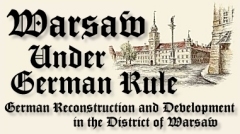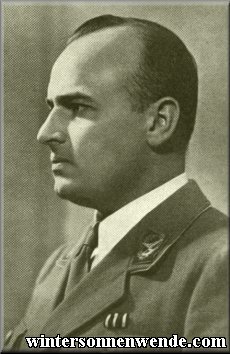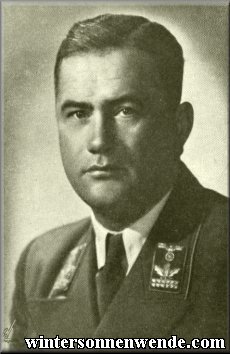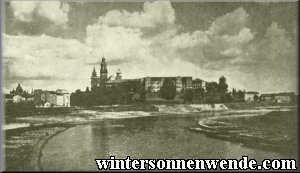 |
 Preface On the occasion of the second anniversary of the General Government,* I commissioned a report about the work that had been done in the District of Warsaw. This report appeared in book form and was titled
"Zwei Jahre Aufbauarbeit im Distrikt Warschau" (Two Years of Reconstruction and Development in the District of Warsaw). It was a matter of only a few weeks before all 3,000 copies of the book had been sold. Numerous orders from the Reich could not be filled. In light of the great interest generally expressed in the General Government, I have therefore decided to publish a second, considerably expanded and completely revised edition of the book. This book is the definitive study of German reconstruction and development work in the District of Warsaw, and is a historical documentation of the little-acknowledged labors of the German men and women who have done their duty here ever since the General Government was established. It shall reassure them that their work – often performed under the most trying of conditions, and by its very nature not likely to find much outside appreciation – is by no means forgotten. Above and beyond that, this book shall introduce to anyone desiring to familiarize himself with the East some of the manifold problems which this newly acquired region poses for us. It is one of the political duties of every German to take an interest in these matters. The best possible subject for such study is the General Government: it represents the reconfiguration of the Eastern regions, an endeavor which has been crowned with complete success even in the midst of the greatest war in history.
Warsaw, September 1, 1942, the third anniversary of the beginning of the war. Governor

 Introduction: The Changing Face of Warsaw Since 1939 Shortly before the outbreak of war, and for a long time after the end of the Polish Campaign, the name on everyone's lips was "Warsaw". Warsaw – that was the capital of the former Polish state which the Treaty of Versailles had instated as ruler of the Vistula. For more than 20 years, the Polish powers-that-be did everything they could to turn this city into a "Paris of the East", thus to create a political focus for that Great Polish Empire which was to be the realization of the Polish nationalists' pipe-dream demand, "Polska od morza do morza" – Poland from sea to sea. Warsaw – for us Germans, that was also the embodiment of all anti-German endeavors. In the Polish Council of State, envoys of the German Reich more than once presented offers from the Führer which were intended to achieve peaceful co-operation between the two neighboring states, but the Polish government, in its blindness, never took any notice of them. Willingness to reach agreements was professed for appearances' sake; yet at the very same time, long before the outbreak of the war, the Polish Ministerial Council was the site of those negotiations which, as documents later discovered in the Palais Brühl clearly proved, spun those threads to London, Paris and Washington whose purpose it was to ensnare and isolate the Greater German Reich. Similar maneuvers had been practiced in the first world war; and now, as then, they led to war. Warsaw – in September of 1939 that name became the symbol for futile Polish resistance, but at the same time also for the invincible power of German weapons, which crush anyone presumptuous enough to challenge them. Later, in the course of the war, other European cities were also hard hit, and in some of them – in Rotterdam or Dunkirk, for example – there was even greater destruction than had been the case in Warsaw, yet Warsaw has always had a kind of special status because it was the first major European city to experience the power of German weapons, and the first to be struck from the ranks of European capitals.
This political decline, however, by no means marks the end of Warsaw. On the contrary: Warsaw has since risen from the ruins of the Polish Campaign and advanced to new life under German rule. Three years of German reconstruction and development have turned Warsaw from a city of ruins, as which it appeared when the troops moved in, into an industrious city of work for Germany. This transformation was possible only by virtue of the tremendous reconstruction accomplished between 1939 and 1942 in Warsaw and the entire District. The present volume shall tell of this work, the achievement of a small group of German men and women. Anyone who in the course of this war has seen action in the East will know that all work done thus far has only been preliminary in nature and that a permanent solution to the real political problems of the Vistula region will only be achieved after the end of the war, when the final decision regarding the configuration of this new region of the Greater German Reich has been made. And that is also when the future of Warsaw, the only city with a population of more than a million in this region, will be decided once and for all.

*[Trans. note:] The General Government was not a 'government' in the traditional sense of the term; rather, it was a governorate, a civil administrative system which, while possessing that certain degree of governmental autonomy required for
war-time territorial administration, was nevertheless subordinate to the government of the German Reich. It is therefore by no means redundant to speak of the ‘administration' versus the ‘government' of the
General Government. – At the same time, the term 'General Government' is also used to denote the geographical area in question. Hence, terms such as 'the population of the General Government'. It is most important to keep these distinctions in mind. ...back...
|










